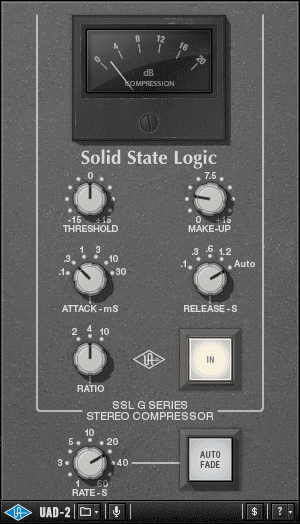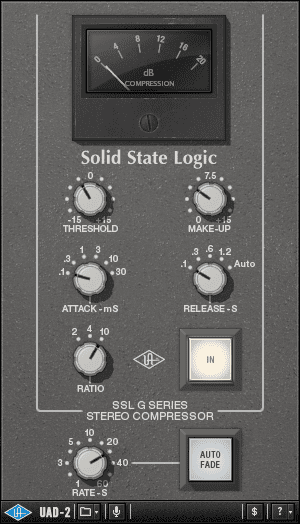Stick Together
So far we’ve considered individual mix elements, but when compression is applied to multiple parts simultaneously it takes on a very different role, most notably acting as a form of sonic glue to bring all the components together. Take the drums:
By routing them to a dedicated drum group and applying gentle compression that only impacts on the main peaks, the drums begin to gel together:
The effect of even minor bus compression like this is to subtly alter the relationship between all constituent parts, in this case reinforcing the groove. But there can also be unwanted side effects – note the slight softening of the snares. If this doesn’t suit the track, try easing off on the bus compression, boosting the snare level slightly and possibly applying some subtle EQ.
Across The Mix
A similar approach can be taken when processing the whole mix. It’s not uncommon to apply gentle compression to the mix bus (we went into more detail on this topic in a previous tutorial).
Although there are a few different approaches to mix bus compression, it’s often beneficial to apply it after you’ve got a solid rough mix formed (rather than at the end of a mix), as it will inform channel and effect level choices.
Before mix bus compression:
And after:
Traditionally, mix bus compression has been no more than a delicate final touch to make the mix cohesive without dramatically altering its dynamics. However, some dance music producers employ much more extreme compression as a final stage of processing – even before the mastering stage. It’s not uncommon for the last stage of compression to use a ratio of 10:1 or over, which takes us into the territory of limiting, especially with the fast attack and release times employed here:
This increases the apparent loudness and starts to introduce a noticeable pumping effect. Although some producers employ this as part of their sound from the earliest stages of a mix, it’s usually advisable to save it for the final stages of the process; the mixdown should generally sound as balanced and cohesive as possible before trying to make it loud. And while the temptation to hammer a mix like this can be difficult to resist, attempts to make tracks as loud as possible are almost always best left to a skilled mastering engineer.
Compression may be one of the most versatile tools at our disposal, but that versatility can also make it a little confusing at times. Now that we’ve covered the basics of the main ways compressors can be used, we can move on to the specifics of how we go about setting the compressor to achieve particular results…
Editor’s note: This article is an amended version of an earlier feature.




10.48 AM
Glad to see that this article got a re-work. The first version felt a little rushed, and whilst I don’t doubt the credentials of the author, some of the examples were very odd. I personally thought that it didn’t put enough emphasis on how complex compression is as a tool.
Obviously there is too much to cover in one article, but because compression can be such a subtle technique, it really requires a solid understanding of it’s applications from the outset. When I was initially taught about it, and then in passing that knowledge on, I’ve always found the most fundamental thing to know, is not how to use compression, but when to use it.
You’ve set yourself an incredibly high standard with your walkthrough and tutorial articles, you’re one of the best resources available for this kind of thing, it’s good to see that you decided to give the piece a little more attention.
01.44 PM
Thank You SO MUCH guys, I have been “Producing” for around 3 years and finally somone takes the time to explain compression correctly. Thank you so much again for doing this!
04.13 PM
Thanks for this.
I thought the audio examples were excellent in bringing the respective points across.Thanks again !